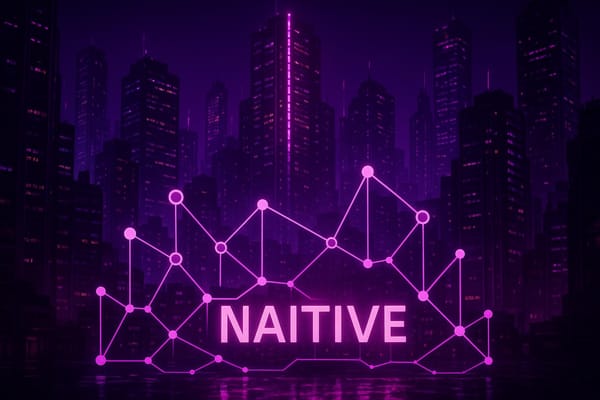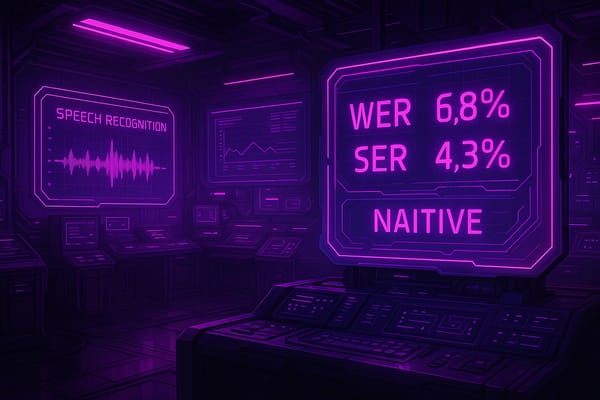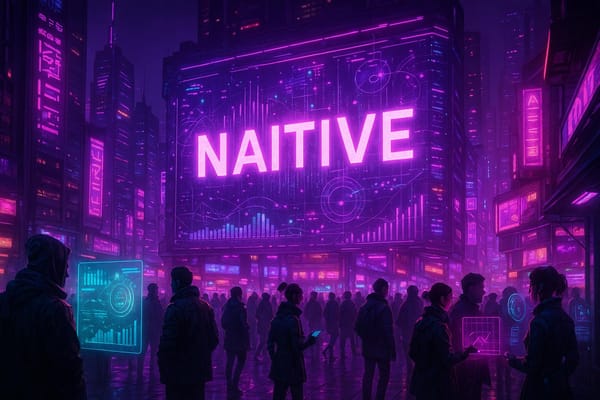Top 7 Open-Source AI Agent Frameworks
Explore the top 7 open-source AI agent frameworks that enhance automation and streamline business operations, each offering unique strengths and capabilities.
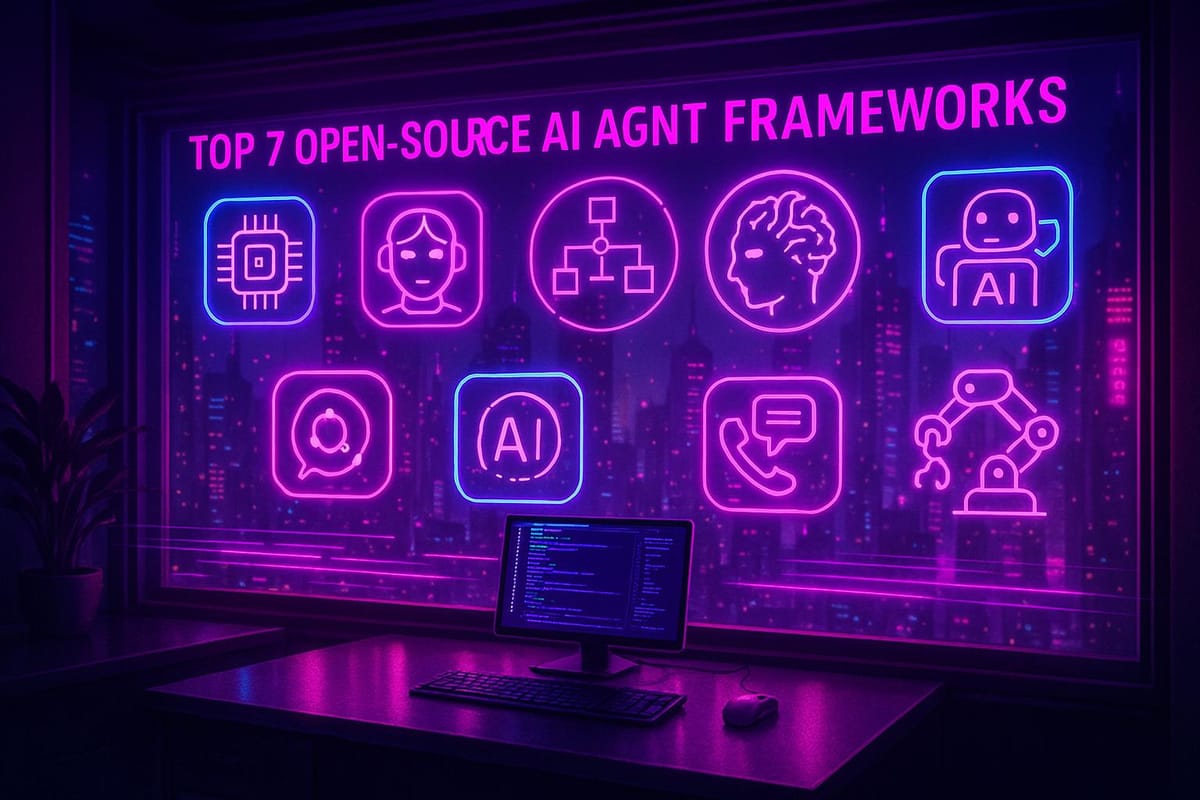
Open-source AI agent frameworks are transforming how businesses automate and scale operations. Whether you're building complex workflows, automating repetitive tasks, or integrating AI into your systems, these frameworks offer the tools you need. Here’s a breakdown of the top 7 frameworks and what makes each one stand out:
- LangGraph: Ideal for complex workflows with advanced debugging and branching capabilities.
- OpenAI Agents SDK: Perfect for teams already using OpenAI's ecosystem, offering tool integration and flexibility.
- Smolagents: A lightweight option for quick, simple automation tasks.
- CrewAI: Best for multi-agent collaboration, managing tasks that require specialized roles.
- AutoGen: Focused on real-time, event-driven multi-agent interactions.
- Semantic Kernel: Designed for enterprise-grade stability, with strong Microsoft ecosystem integration.
- LlamaIndex Agents: Great for retrieval-augmented generation (RAG) and advanced document processing.
Quick Comparison Table
| Framework | Core Strength | Best For |
|---|---|---|
| LangGraph | Workflow control and debugging | Complex, multi-step tasks |
| OpenAI Agents SDK | Integration with OpenAI tools | Teams using OpenAI's ecosystem |
| Smolagents | Lightweight and simple setup | Quick prototypes and task-specific solutions |
| CrewAI | Multi-agent collaboration | Role-based workflows and team tasks |
| AutoGen | Event-driven multi-agent interactions | Real-time, dynamic scenarios |
| Semantic Kernel | Enterprise-grade stability | Microsoft ecosystem and enterprise needs |
| LlamaIndex Agents | Advanced document retrieval and RAG | Complex data processing and knowledge retrieval |
Each framework has its strengths, so choose based on your project’s scalability, integration needs, and complexity. For detailed insights, continue reading the full article.
AI Agents from Scratch using Open Source AI
How to Choose an Open-Source AI Agent Framework
Picking the right open-source AI agent framework isn't just about downloading the latest tool - it requires a thoughtful evaluation of several factors. For context, 70% of organizations encounter hurdles during AI implementation, often due to compatibility issues. Let’s break down the key considerations to help you make an informed choice.
Scalability and Performance Requirements should be at the forefront of your decision. Your chosen framework needs to handle increasing workloads efficiently. Whether you’re scaling horizontally for large, dynamic operations or vertically for smaller, predictable tasks, the framework must adapt to your business’s growth.
Integration Capabilities are equally crucial. How well will the AI agents fit into your existing systems? Before committing to a framework, take stock of your current software, hardware, and data management tools. Outdated infrastructure is a common stumbling block, with 50% of organizations citing it as a major barrier to AI adoption. Look for platforms with strong APIs and SDKs to ensure smooth integration with your tech stack.
Security and Compliance cannot be overlooked, especially in industries with strict regulations. Data security is more critical than ever, with a 76% rise in data theft and a 75% increase in cloud intrusions reported in 2024. Choose frameworks that emphasize security, offering features like detailed audit trails, robust access controls, and effective data governance. For instance, JPMorgan Chase's COIN platform and the Mayo Clinic's AI agents are excellent examples of systems that combine security with regulatory compliance while saving countless hours of manual work.
Community Support and Documentation play a significant role in your framework’s success. An active community can speed up problem-solving, while detailed documentation reduces the learning curve for your team. Check GitHub activity, issue response times, and the availability of tutorials to assess community engagement.
Customization Flexibility is another factor to weigh. Some frameworks prioritize standardization for simplicity, while others allow extensive customization, even if it adds complexity. Your choice should align with your team’s technical expertise and project needs.
When it comes to Deployment Preferences, consider your operational goals. Cloud-based platforms offer elastic scaling and pay-as-you-go pricing, making them a popular choice. On the other hand, on-premises solutions provide tighter control over hardware and security. Gartner predicts that by 2028, over 80% of data center workload accelerators will focus on inference, reflecting a shift toward operational efficiency [5].
Data Governance Capabilities are essential for enterprise-level deployments. Look for frameworks that support features like data catalogs, lineage tracking, and privacy-enhancing technologies. Organizations that implement strong data governance practices, such as forming committees or promoting data literacy, often outperform their peers. In fact, top-performing companies are 2.3 times more likely to have a governance committee and 2.5 times more likely to invest in data literacy programs.
Lastly, don’t overlook the Total Cost of Ownership. Initial implementation costs are just the beginning - factor in training, ongoing maintenance, infrastructure upgrades, and scaling expenses. Companies that invest in upskilling their teams or work with expert AI consultants often achieve better long-term outcomes.
Before finalizing your choice, test frameworks in controlled environments and involve cross-functional teams to refine your selection process. This approach will help ensure that the framework you choose aligns with your organization’s unique needs.
1. LangGraph
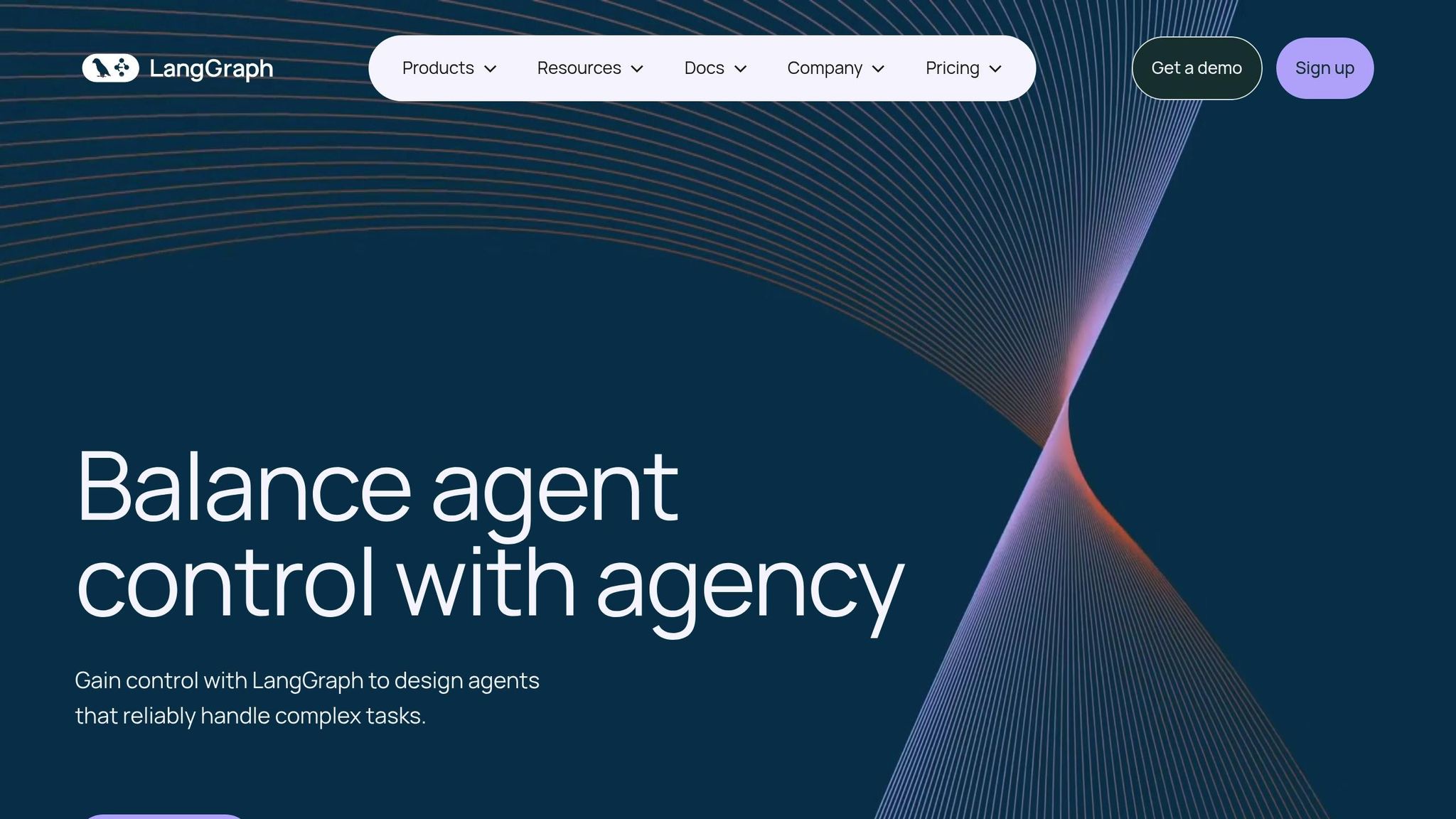
LangGraph is a stateful orchestration framework designed for multi-actor applications that leverage large language models. Unlike more rigid frameworks, LangGraph allows for the creation of sophisticated agent workflows tailored to complex business needs. It's already making waves in the enterprise world, with companies like LinkedIn, Uber, Klarna, and GitLab using it to power AI agents in production environments.
Scalability and Production Readiness
LangGraph is built with enterprise-scale operations in mind. Its platform supports fault-tolerant scalability through horizontal server scaling, task queues, persistence, intelligent caching, and automated retries. A standout feature is its built-in memory, which stores conversation histories and maintains context across sessions, enabling personalized interactions over time. The framework is also optimized for streaming workflows, ensuring smooth and efficient operations.
"LangChain is streets ahead with what they've put forward with LangGraph. LangGraph sets the foundation for how we can build and scale AI workloads - from conversational agents, complex task automation, to custom LLM-backed experiences that 'just work'. The next chapter in building complex production-ready features with LLMs is agentic, and with LangGraph and LangSmith, LangChain delivers an out-of-the-box solution to iterate quickly, debug immediately, and scale effortlessly."
– Garrett Spong, Principal SWE
Integration Capabilities with Enterprise Systems
On top of its scalability, LangGraph excels in integrating with enterprise systems. It uses a shared application state modeled with Pydantic, allowing for memory persistence, contextual awareness, and detailed task tracking. Its graph-based structure efficiently handles relationships within AI workflows, making it ideal for managing complex enterprise processes. LangGraph also integrates seamlessly with LangChain, offering access to a wide array of tools and language models. For instance, Norwegian Cruise Line relies on LangGraph to develop and refine guest-facing AI solutions, benefiting from its ability to manage multi-step reasoning and maintain contextual awareness.
"LangGraph has been instrumental for our AI development. Its robust framework for building stateful, multi-actor applications with LLMs has transformed how we evaluate and optimize the performance of our AI guest-facing solutions. LangGraph enables granular control over the agent's thought process, which has empowered us to make data-driven and deliberate decisions to meet the diverse needs of our guests."
– Andres Torres, Sr. Solutions Architect
These integration capabilities make LangGraph particularly appealing for enterprises looking to streamline their AI workflows.
Community Support and Documentation
LangGraph benefits from a vibrant community and a wealth of educational resources. LangChain’s YouTube channel, with 117,000 subscribers, features detailed courses on LangGraph. Developers can also access LangChain Academy, a free course covering LangGraph essentials, alongside comprehensive documentation filled with guides, references, and practical examples to help users get up to speed quickly. LangGraph Studio offers a visual environment for prototyping, debugging, and sharing agents, while LangSmith integration enhances agent evaluation and observability.
Customization and Extensibility
Released under the MIT license, LangGraph is freely available for commercial use and highly customizable. It provides granular control over agent workflows and states, making it adaptable to specialized use cases. Replit, for example, uses LangGraph to develop coding agents for millions of users, with a strong emphasis on reliability:
"It's easy to build the prototype of a coding agent, but deceptively hard to improve its reliability. Replit wants to give a coding agent to millions of users - reliability is our top priority, and will remain so for a long time. LangGraph is giving us the control and ergonomics we need to build and ship powerful coding agents."
– Michele Catasta, President
The LangGraph Platform also includes templated cognitive architectures, where tools, prompts, and models are easily configurable via Platform Assistants. For enterprises diving into advanced AI projects, working with experts can make all the difference. NAITIVE AI Consulting Agency specializes in designing and deploying autonomous AI agents, helping businesses navigate the challenges of enterprise AI integration.
2. OpenAI Agents SDK
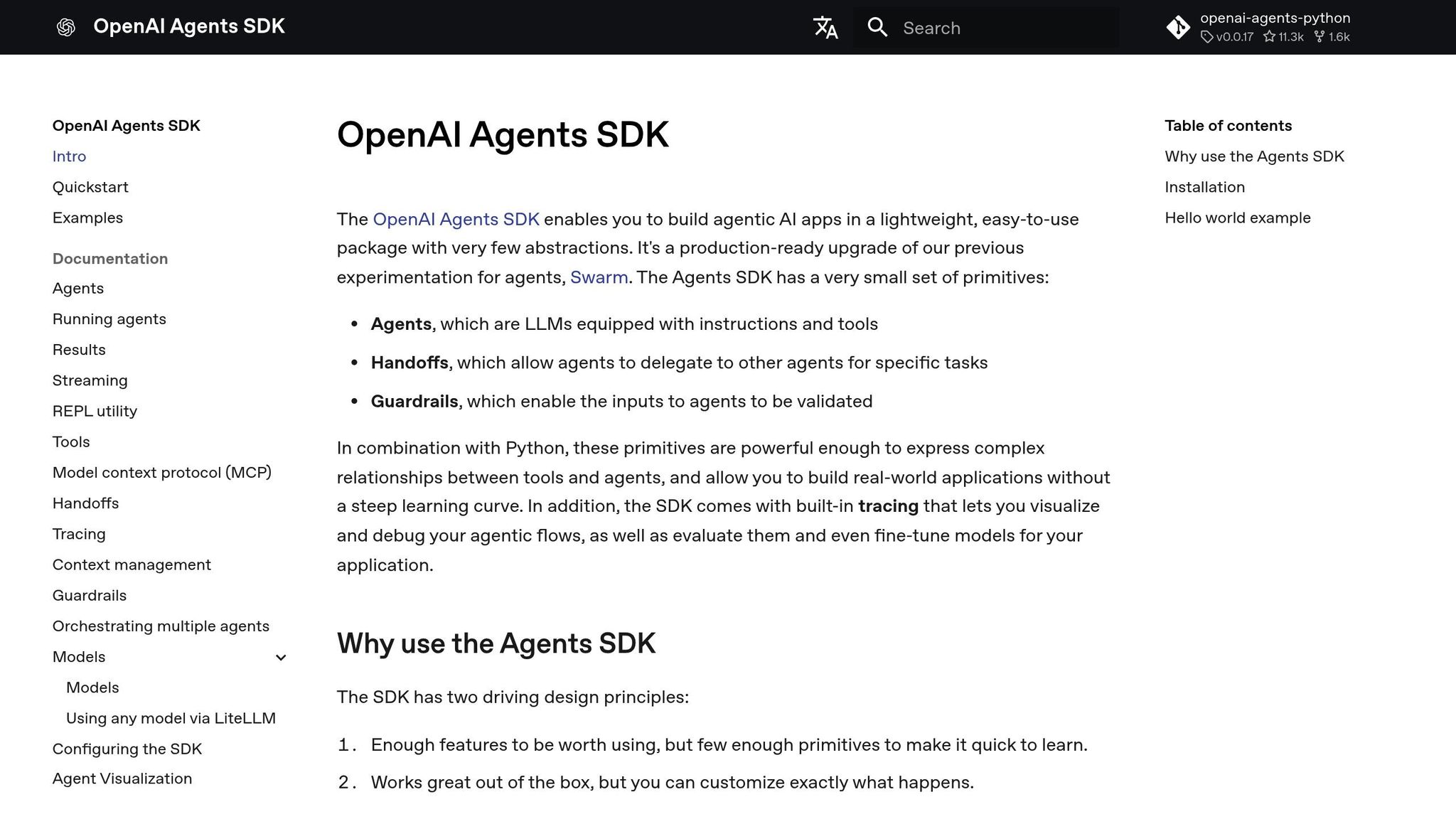
The OpenAI Agents SDK is a Python-based, open-source framework designed to streamline the development of intelligent AI agents. Built on OpenAI's experimental Swarm project, the SDK simplifies the creation of agents that can follow instructions, utilize tools, and manage complex tasks within organizational workflows.
Scalability and Production Readiness
The SDK is designed for large-scale deployments, offering features like asynchronous execution, seamless API integration, and built-in load balancing. These capabilities make it easier to automate repetitive tasks, such as customer support and research, while also reducing operational costs.
"We think the coming months are going to be critical for deploying more and more agents at scale"
This combination of scalability and efficiency makes the SDK a practical choice for integrating AI agents into diverse enterprise systems.
Integration Capabilities with Enterprise Systems
The SDK has already demonstrated its ability to transform enterprise workflows. For instance:
- Box: In March 2025, Box introduced an AI agent powered by the OpenAI SDK. This agent can securely search, query, and retrieve data from files while respecting existing security protocols. This is particularly beneficial for industries like financial services, where custom agents can merge internal market analysis with real-time economic data.
- Stripe: By embedding its financial services into agent workflows, Stripe has automated processes like contractor payments.
- Coinbase: Its AgentKit allows for seamless interactions with crypto wallets, simplifying user experiences.
The SDK also supports integration with the Responses API and Chat Completions API, as well as models from other providers offering Chat Completions-style endpoints. This flexibility ensures enterprises can avoid vendor lock-in while building tailored solutions.
"For enterprises, the new OpenAI Agents SDK will be most powerful when they are leveraged not only for reasoning from within the models or the broader internet, but also when these can be combined with external systems and proprietary data sources, like their unstructured data stored in Box."
Other companies, like Navan and Unify, are also leveraging the SDK. Navan uses its file search capabilities to deliver accurate, personalized responses from knowledge-base articles. Meanwhile, Unify integrates APIs to enable tasks like verifying real-estate expansions through online map data.
These integrations are paving the way for more efficient enterprise automation, supported by a growing community of contributors.
Community Support and Documentation
As an open-source framework, the SDK encourages collaboration and customization. OpenAI has established a dedicated developer forum where professionals can exchange ideas and solutions. Additionally, the SDK comes with detailed documentation, tutorials, and built-in observability tools to aid in debugging and optimization.
Customization and Extensibility
One of the SDK's standout features is its adaptability. For example, Luminai used the framework to integrate a computer use tool, automating operational workflows for organizations with outdated systems that lack APIs. Tasks like application processing and user enrollment, which previously took months, were completed in just days using the SDK.
"The Agents SDK is open‑source, allowing enterprises to mix and match different models. We don't want to force anyone to use only OpenAI models"
This open-source flexibility also enables the orchestration of multi-agent workflows. For businesses looking to implement advanced AI solutions, NAITIVE AI Consulting Agency offers expertise in building scalable and integrated agent systems.
3. Smolagents
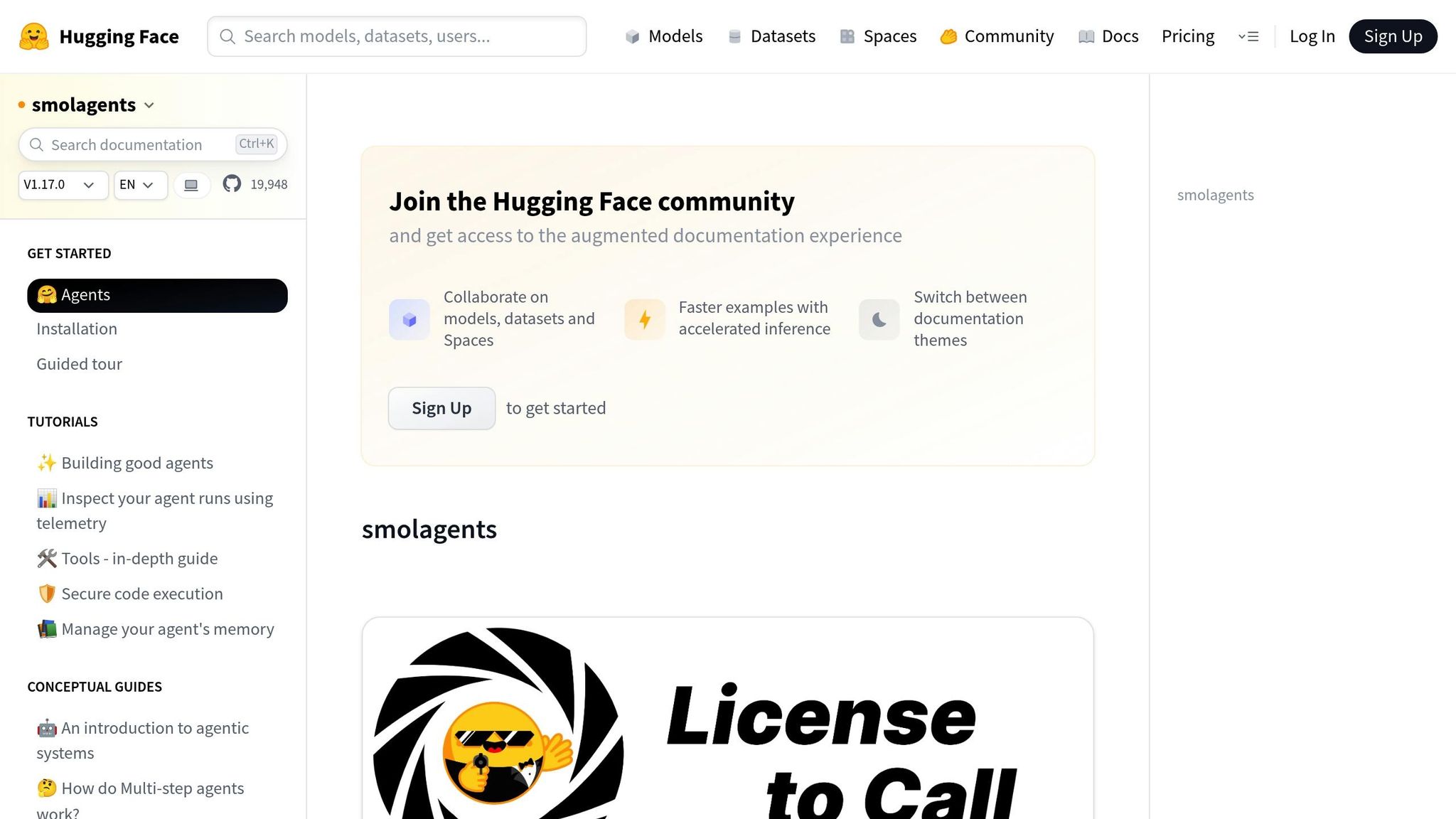
Smolagents is a lightweight framework created by Hugging Face, designed to simplify the process of building autonomous AI agents. With just about 1,000 lines of code in its agents.py file, this framework prioritizes simplicity and efficiency, avoiding the complexity of larger, monolithic models. It’s tailored for developers who need task-specific AI solutions without unnecessary overhead. Let’s take a closer look at what makes Smolagents a practical choice for enterprise applications.
"SmolAgents from Hugging Face offers a robust framework for building intelligent, task-specific agents...it is an indispensable library for AI developers." - DhanushKumar, Data Science || Machine Learning || Deep Learning || Language Models || GenAI || Azure AI & Data || Microsoft Student Ambassador - Gold
Scalability and Production Readiness
Smolagents delivers measurable efficiency for enterprise use cases. By streamlining processes and reducing the number of large language model (LLM) calls by 30%, it lowers operational costs while improving response times.
Security is a top priority for this framework. It enables secure code execution through features like a local Python interpreter with restricted imports and integration with E2B for sandboxed environments. These mechanisms ensure that enterprises can deploy agents safely without risking system integrity.
For monitoring and debugging in production, Smolagents integrates with OpenTelemetry, providing robust observability tools that make it easier to track and optimize deployments.
Integration Capabilities with Enterprise Systems
Thanks to its modular architecture, Smolagents easily integrates with both proprietary and open-source AI models, making it highly adaptable to various enterprise environments. It also supports custom tool development, allowing businesses to tailor solutions to their specific needs.
One standout feature is its ability to write and execute Python code directly. This capability enhances both efficiency and accuracy, especially when managing complex enterprise tasks.
Community Support and Documentation
Smolagents benefits from a thriving community within the Hugging Face ecosystem. The GitHub repository has gained significant traction, boasting 19.9k stars and 1.7k forks from 144 contributors across 24 releases (as of May 27, 2025). Integration with the Hugging Face Hub further strengthens its appeal, allowing developers to share and access tools effortlessly.
"Being integrated well into the Hugging Face ecosystem means more models and tools at hand, plus the support of the open-source community."
The framework also offers comprehensive resources to help developers get started, including guided tours, how-to guides, conceptual overviews, and tutorials.
Customization and Extensibility
Smolagents shines in its flexibility, thanks to its modular design. Developers can easily customize and scale their agents to meet unique business requirements.
"Reducing the complexity of building AI agents to just three lines of code is a remarkable achievement that democratizes access to advanced AI workflows." - Ganesh Jagadeesan, Enterprise Data Science Specialist @Mastech Digital
Its code-driven intelligence approach sets it apart from other frameworks. By breaking down complex tasks into smaller, manageable steps, developers can optimize token usage and maintain context more effectively.
For enterprises looking to implement sophisticated AI agent solutions without the burden of complexity, Smolagents offers a compelling option. Companies like NAITIVE AI Consulting Agency specialize in leveraging this lightweight framework to deliver scalable and efficient autonomous agent deployments. Up next, we’ll explore another framework that highlights the power of open-source tools in AI development.
4. CrewAI
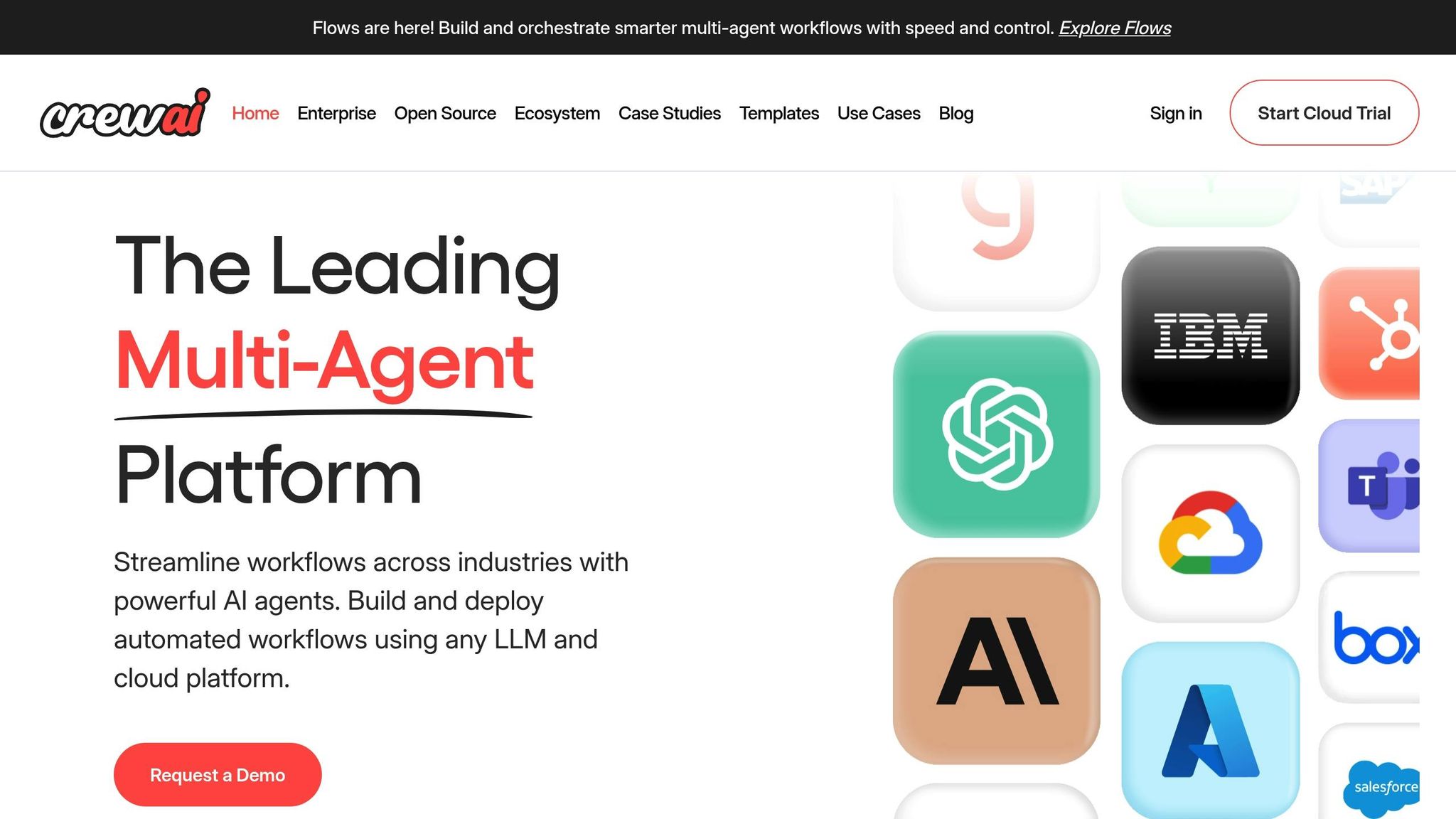
CrewAI is a multi-agent framework trusted by 60% of Fortune 500 companies across more than 150 countries. With 29.4k GitHub stars and over 100,000 developers trained on its platform, CrewAI has established itself as a leader in the field of collaborative AI systems. This framework organizes AI agents into teams - referred to as "crews" - where each agent takes on specific roles to address complex business challenges. As Ben Tossell, Founder of Ben's Bites, describes it:
"It's the best agent framework out there and improvements are being shipped like nothing I've ever seen before!"
Scalability and Production Readiness
CrewAI isn’t just widely adopted; it’s built to handle the demands of enterprise-level operations. Its scalable architecture allows for flexible deployment, whether through on-premises setups for enhanced control and compliance or integrations with major cloud providers like AWS, Azure, and Google Cloud Storage.
For production environments, CrewAI offers real-time monitoring of crew performance and task progress. It also integrates with third-party tools for tracking metrics and setting up observability for large language models and vector databases. Security is a top priority, with CrewAI meeting stringent enterprise standards while providing 24/7 premium support and advanced user management features.
Integration Capabilities with Enterprise Systems
CrewAI stands out for its ability to integrate with over 1,200 applications, enabling seamless workflows. Its Enterprise offering takes this further with API access, pre-built connectors, and a dedicated Tool Repository filled with ready-to-use integrations. Real-time updates are supported through webhook streaming, while the CrewAI CLI allows for advanced, customizable deployment workflows tailored to specific enterprise needs.
Community Support and Documentation
CrewAI prioritizes developer success by offering a wealth of educational resources. Its structured learning paths cater to a range of users, from beginners learning to customize sequential processes to advanced developers creating multimodal or custom manager agents. The platform also provides detailed documentation with practical examples, an active community forum, and direct technical support via email (support@crewai.com). This ensures that both individual developers and enterprise teams have the guidance they need throughout their journey.
Customization and Extensibility
CrewAI’s modular design makes it easy to implement and customize for specific needs. Jack Altman, Managing Partner at Alt Cap, highlights its value:
"Given the pace of technological change, engineers leveraging platforms like CrewAI will have a huge leg up and get stronger the more change happens. CrewAI simplifies and accelerates your journey into the future of AI, empowering you to set new standards in software development."
Organizations can choose between CrewAI Enterprise’s managed infrastructure or self-hosting on their preferred cloud service. This flexibility ensures that CrewAI can adapt to diverse technical requirements and compliance standards. For enterprises aiming to deploy sophisticated multi-agent AI systems, CrewAI offers a powerful combination of scalability, seamless integration, and extensive community support. Companies such as NAITIVE AI Consulting Agency use CrewAI’s collaborative agent framework to build autonomous systems capable of managing intricate business processes.
5. AutoGen
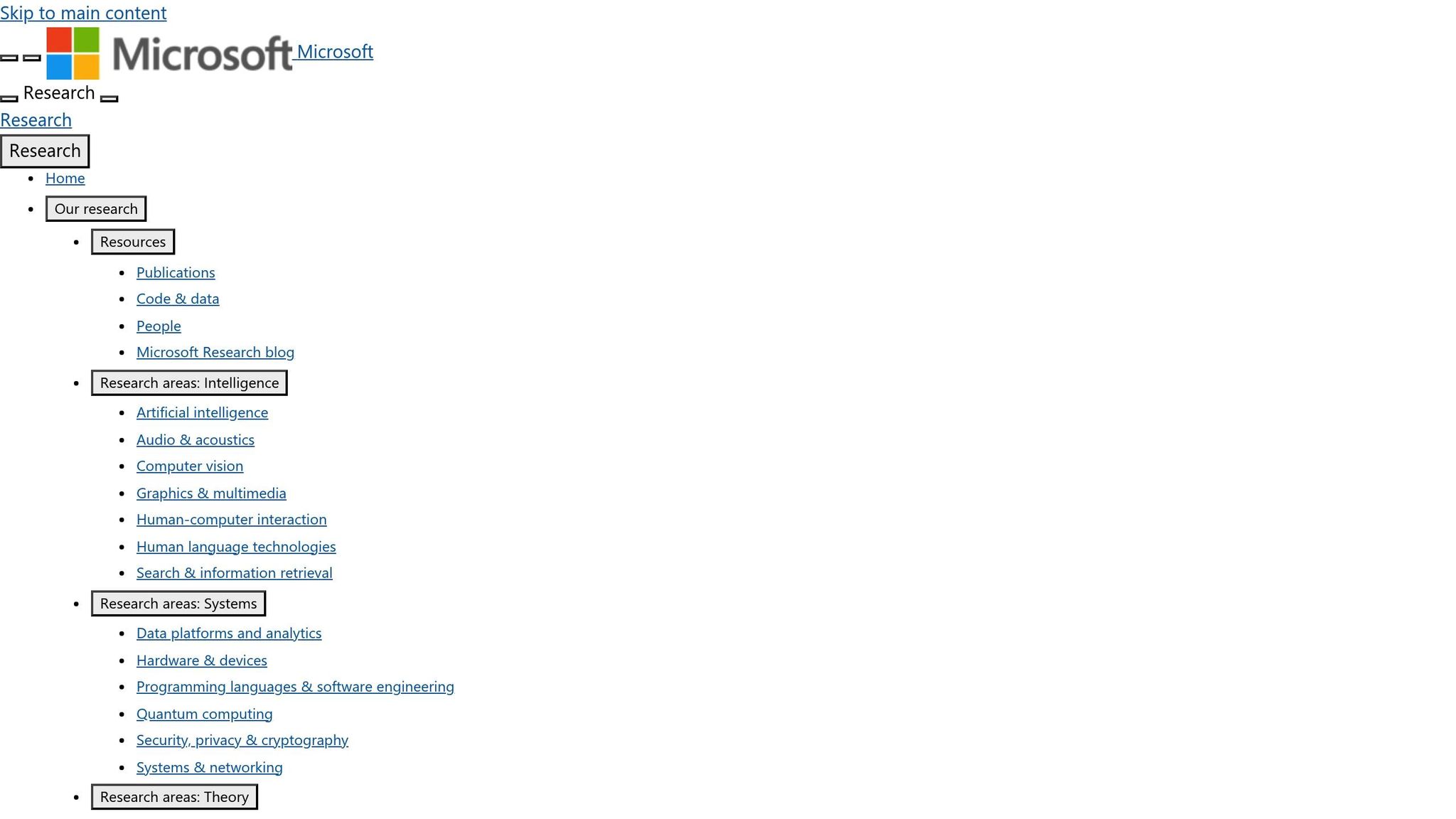
AutoGen is a framework designed for creating multi-agent AI systems with a focus on interaction and communication. Its event-driven architecture allows agents to respond dynamically, giving developers fine-grained control over logic and workflows. This makes it ideal for scenarios that require continuous feedback and task delegation.
Scalability and Production Readiness
AutoGen v0.4 has been revamped to tackle the demands of enterprise-scale operations. Its asynchronous, event-driven design supports a wide array of agent-based scenarios and enables the creation of complex, distributed networks that can function across different organizational units. The framework comes equipped with tools for tracking, tracing, and debugging agent interactions, alongside OpenTelemetry support for comprehensive monitoring. Essentially, AutoGen serves as an "R&D lab" for developing agents iteratively, while its Multi-Agent Collaboration Platform (MCP) acts as a hub for scaling production deployments.
Integration Capabilities with Enterprise Systems
AutoGen integrates smoothly into existing enterprise workflows. It works with popular development tools, cloud services, and APIs, ensuring compatibility with existing systems and fostering team collaboration. In its Business-in-a-Box model, multiple agents work together to automate intricate workflows. For instance, a Procurement Agent can detect when human input is needed, notify supervisors for approval, and once approved, issue badges and arrange deliveries to the nearest office location. Another example highlights its ability to streamline product releases - agents like the Product Agent, Marketing Agent, and Legal Agent collaborate to handle updates, draft press releases, and secure necessary approvals, reducing the need for manual coordination.
Community Support and Documentation
AutoGen simplifies tasks like data preprocessing, model training, and deployment monitoring. Its multi-agent systems can be tailored to align with an organization’s structure, ensuring that information remains accurate and relevant across various departments and use cases.
Customization and Extensibility
AutoGen’s modular design allows users to integrate custom agents, tools, memory, and models. This is supported by a core framework, the high-level AgentChat API, and third-party extensions. Developers can use Python to create specialized agents by connecting external APIs, refining decision-making logic, and optimizing performance to meet specific needs. This level of customization makes AutoGen a flexible solution for a wide range of business applications.
For organizations looking to implement advanced, conversation-driven AI systems, AutoGen offers a powerful way to build sophisticated workflows. Companies like NAITIVE AI Consulting Agency use AutoGen’s event-driven framework to design adaptive autonomous agents that handle complex business challenges and dynamic decision-making processes effectively.
6. Semantic Kernel
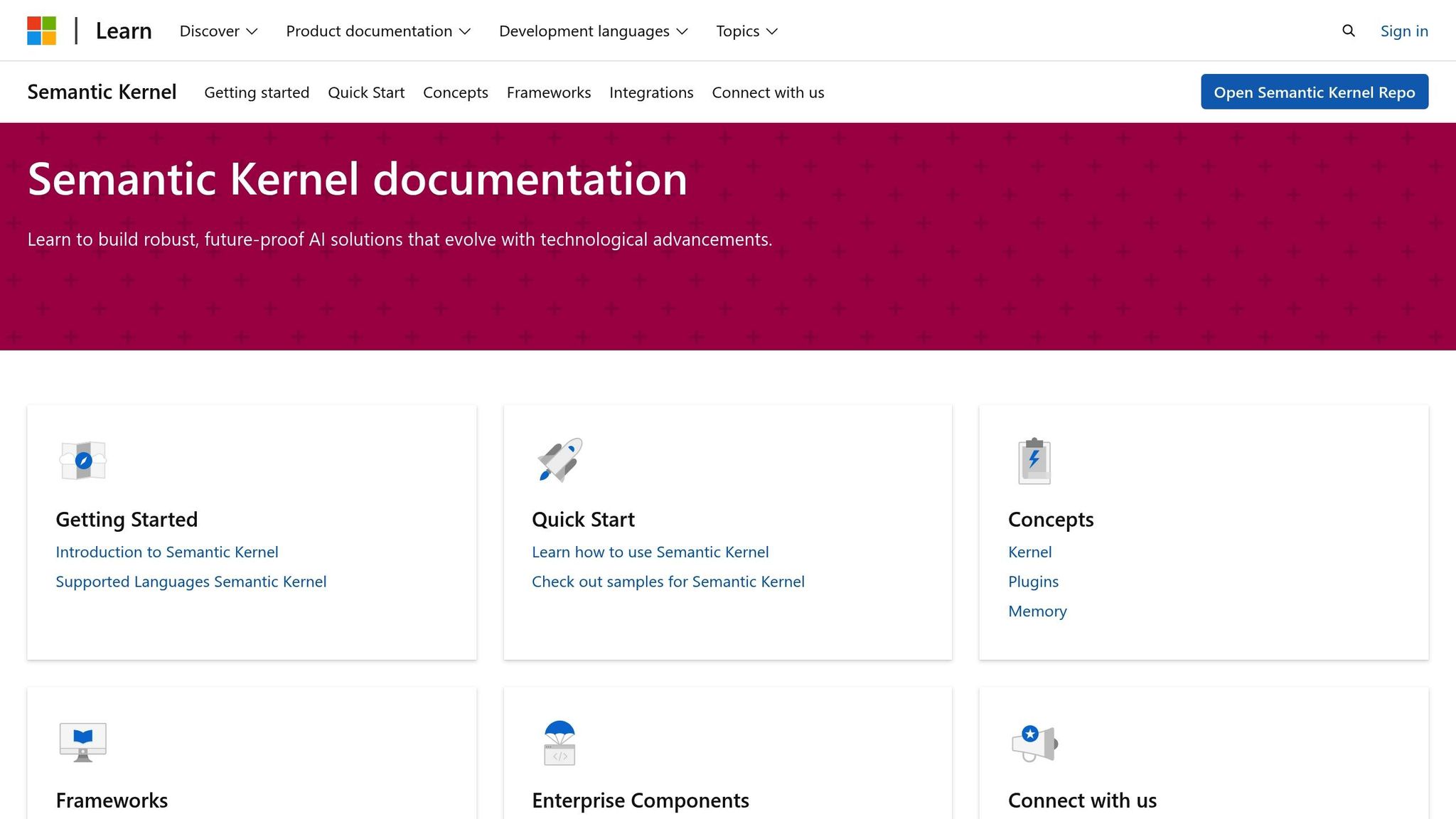
Semantic Kernel is Microsoft's open-source framework designed for building AI agents with enterprise-grade stability and seamless integration. This lightweight toolkit enables developers to embed cutting-edge AI models into applications using C#, Python, or Java, making it a versatile choice for businesses.
Scalability and Production Readiness
From the start, Semantic Kernel was crafted to meet the demands of enterprise-scale applications. With version 1.0+ support for C#, Python, and Java, it ensures stable, non-breaking updates - an essential feature for enterprise teams. This reliability makes it an attractive option for Fortune 500 companies, where long-term support and predictable performance are critical.
Its modular design allows for scalable development and maintenance, while its compatibility with a variety of AI models ensures it can adapt to emerging technologies. Microsoft and numerous Fortune 500 companies already use Semantic Kernel in production, proving its readiness for large-scale enterprise operations.
The framework includes a Process Framework that supports stateful, long-running processes, ideal for autonomous agents and workflows involving human interaction. These processes can be distributed and scaled efficiently using Dapr and Microsoft Orleans, enabling organizations to manage complex, enterprise-level tasks effectively.
For added reliability, Semantic Kernel offers telemetry support, hooks, and filters tailored for responsible AI solutions at scale.
Integration Capabilities with Enterprise Systems
Semantic Kernel excels in bridging AI capabilities with existing enterprise systems. It integrates Large Language Models (LLMs) into traditional programming environments through a modular approach, using discrete, reusable components.
Its plugin system transforms existing APIs into reusable collections, allowing AI agents to work with legacy systems and data sources without requiring a complete overhaul of existing infrastructure. This approach not only saves time but also maximizes the value of current investments.
The framework further supports integration through OpenAPI specifications, similar to Microsoft 365 Copilot. This enables organizations to share extensions across teams, including professional developers and low-code users. Over 230,000 organizations, including 90% of Fortune 500 companies, have used Copilot Studio to build AI agents and automation workflows. These agents can directly interact with tools like OneDrive, SharePoint, and Microsoft Teams, and Microsoft has introduced connectors for widely used third-party platforms like Salesforce, ServiceNow, Zendesk, and data sources such as Snowflake, Databricks, and SAP.
Community Support and Documentation
Microsoft backs Semantic Kernel with extensive documentation and a strong community network, making it easier for developers to extend AI capabilities across the Microsoft ecosystem. By offering a consistent programming model and prioritizing transparency and control, the framework is particularly well-suited for mission-critical applications where thorough documentation and support are essential.
Customization and Extensibility
Thanks to its modular architecture, Semantic Kernel offers developers the flexibility to customize AI functionalities using discrete, reusable components. This means organizations can import only the plugins they need, minimizing token usage and reducing the risk of errors.
The framework is also designed to accommodate future advancements in AI. Developers can upgrade models without rewriting code, and the use of descriptive function names further enhances performance and usability.
For companies seeking a robust AI framework that integrates effortlessly with Microsoft's ecosystem, Semantic Kernel is a standout choice. Organizations like NAITIVE AI Consulting Agency have already utilized its capabilities to build scalable AI agents that align with modern enterprise needs, maintaining high standards of security and reliability.
7. LlamaIndex Agents
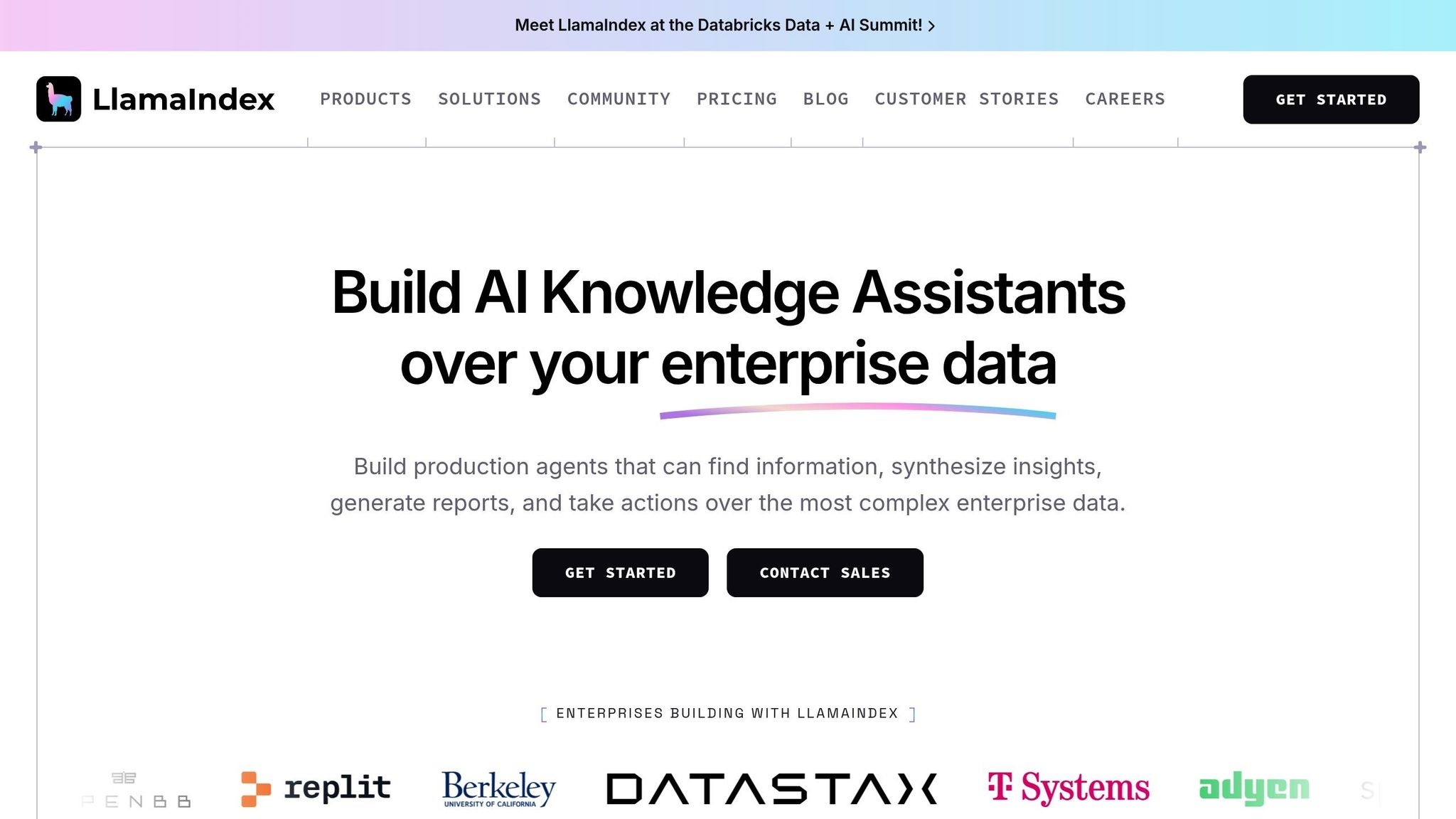
LlamaIndex Agents are reshaping enterprise AI by deploying agents enhanced with contextual understanding. With over 4 million monthly downloads, contributions from more than 1,500 developers, and 150,000+ LlamaCloud signups, it’s become a go-to solution for enterprises looking for advanced AI agent functionality.
Scalability and Production Readiness
The LlamaCloud platform offers enterprise-grade scalability and reliability, featuring tools like Role-Based Access Control (RBAC), Single Sign-On (SSO), and auto-scaling. It accommodates both SaaS and on-premises setups, while its async-first LlamaDeploy streamlines the deployment of complex distributed workflows.
Take Cemex, for instance. This global construction materials company slashed its data pipeline setup time from five weeks to just three hours using LlamaCloud. Similarly, a major professional services firm reduced its delivery timeline from one use case every three months to just 3–4 weeks.
"Cemex, a global construction materials company, has successfully applied AI across its operations since 2018. LlamaCloud has significantly boosted our development process; from taking weeks to develop to delivering value in a few hours. The impressive capacities of LlamaCloud have enabled us to trust and rely on its parsing and indexing capabilities for our complex documents including those with heavy visual content." – Daniel García Zapata, Senior Data Scientist
This level of scalability ensures smooth integration with a wide range of enterprise systems.
Integration Capabilities with Enterprise Systems
LlamaIndex supports over 160 data formats and features hundreds of specialized data loaders for seamless integration with platforms like Airtable, Jira, and Salesforce, as well as standard file formats like JSON and CSV. It also maintains native access controls through direct integrations with tools like Microsoft SharePoint, Box, and S3.
For example, Rakuten shifted its focus from maintaining data pipelines to advancing AI applications, thanks to LlamaIndex. Similarly, Salesforce’s Agentforce team used it to quickly prototype production-ready RAG (Retrieval-Augmented Generation) applications.
Community Support and Documentation
The LlamaIndex community is highly active and accessible through platforms like Discord, Twitter, and LinkedIn. On GitHub, the project boasts over 350,000 stars, reflecting strong developer engagement. LlamaHub serves as a repository for community-created agents and tools, while detailed documentation supports Python and TypeScript users, covering everything from basic setup to advanced workflows. A weekly newsletter also helps developers stay updated on the latest features and best practices.
Customization and Extensibility
Thanks to its modular design, LlamaIndex allows enterprises to create tailored solutions. It supports both prebuilt agents and custom workflows, enabling a balance between quick deployment and bespoke functionality. KPMG, for example, standardized its knowledge assistant development using LlamaCloud’s configurable RAG pipelines for multi-modal data.
"LlamaCloud's capabilities have played a significant role in helping standardize the development of enterprise knowledge assistants at KPMG. The platform's intuitive interface for configuring RAG pipelines allows us to leverage cutting-edge techniques while maintaining consistency. Its ability to handle multi-modal data embedded within documents during both ingestion and retrieval has been valuable in unlocking insights from our diverse enterprise corpora." – Swami Chandrasekaran, Head of AI & Data Labs
For more advanced needs, LlamaParse offers powerful tools for handling complex document layouts, including nested tables and image extraction. This ensures data accuracy in even the most intricate RAG implementations.
Organizations like NAITIVE AI Consulting Agency can harness these capabilities to develop sophisticated AI agent solutions that seamlessly integrate with existing systems while staying adaptable to changing business needs.
Framework Comparison Table
To simplify the decision-making process, here's a comparison table summarizing the key strengths of various AI agent frameworks. This quick reference highlights how each framework handles essential development aspects, helping you align your project needs with the right solution.
| Framework | Core Paradigm | Primary Strength | Best For | Community Support | Enterprise Integration |
|---|---|---|---|---|---|
| LangGraph | Workflow managed via graph structures | Explicit DAG control, branching, debugging | Complex multi-step tasks with branching and advanced error handling | Large LangChain ecosystem with extensive documentation | Strong API/database integration; proven at scale (Klarna, AppFolio) |
| OpenAI Agents SDK | OpenAI-powered tool suite | Integrated tools such as web and file search | Teams relying on OpenAI's ecosystem seeking official support | Official OpenAI backing with a growing developer base | Native OpenAI service integration; enterprise API support |
| Smolagents | Code-centric minimal agent loop | Simple setup with direct code execution | Quick automation tasks without heavy orchestration | Growing community and clear documentation | Lightweight integration; ideal for rapid prototyping |
| CrewAI | Multi-agent collaboration (crews) | Parallel role-based workflows with memory | Complex tasks requiring multiple specialists working together | Active development paired with a simple code structure | Flexible API connections; role-based system integration |
| AutoGen | Asynchronous multi-agent chat | Live conversations and event-driven interactions | Real-time scenarios needing multiple LLM interactions | Backed by Microsoft Research with a user-friendly design | Seamless Microsoft ecosystem integration; enterprise-grade |
| Semantic Kernel | Skill-based enterprise integrations | Multi-language support with enterprise compliance | Enterprise settings, especially within .NET ecosystems | Supported by Microsoft with comprehensive multi-language documentation | Enterprise-grade language flexibility (Python, C#, Java) |
| LlamaIndex Agents | RAG with integrated indexing | Retrieval plus agent synergy | Extensive data lookup, retrieval, and knowledge fusion | Strong community engagement with active development | Supports integration for efficient retrieval tasks |
Key Takeaways from the Comparison
- LangGraph stands out for its proven scalability, with Klarna serving 85 million users while reducing resolution times by 80%, and AppFolio achieving a twofold improvement in response accuracy. Its graph-based approach makes it ideal for workflows requiring precise control and advanced debugging.
- Smolagents is perfect for quick deployments, offering minimal code overhead while focusing on rapid prototyping.
- AutoGen and Semantic Kernel lead the pack in enterprise integration, particularly for organizations heavily invested in the Microsoft ecosystem. Both frameworks provide multi-language support and seamless connectivity to enterprise tools.
- CrewAI balances simplicity with the ability to manage complex multi-agent scenarios, making it a great choice for tasks requiring collaboration among specialized agents.
- LlamaIndex Agents shines in scenarios involving complex document processing and retrieval tasks, thanks to its integration of retrieval-augmented generation (RAG) and strong community engagement.
For companies needing expert guidance in selecting and deploying the right framework, NAITIVE AI Consulting Agency offers tailored solutions designed to align with your enterprise requirements and existing system architectures. Whether you're focused on scalability, speed of deployment, or seamless integration, there's a framework suited to your needs.
Why U.S. Enterprises Choose Open-Source Agent Frameworks
More than half of U.S. enterprises are now leveraging open-source AI agent frameworks. In fact, over 50% of organizations already use open-source AI technologies for their data, models, and tools. This trend reflects a deliberate choice by businesses to embrace innovation while optimizing the deployment of autonomous agents. The reasons behind this shift are both practical and strategic.
One of the biggest motivators? Cost efficiency. With the average base salary for a U.S. data scientist exceeding $125,000, hiring and retaining talent can be expensive. Open-source frameworks help organizations cut costs in other areas, like implementation and maintenance. Research backs this up: 60% of respondents report lower implementation costs, while 46% cite reduced maintenance expenses when using open-source solutions.
Deb Richardson, Senior Content Strategist at Red Hat Blog, highlights the collaborative nature of open-source development:
"Unlike closed organizations and proprietary solutions, when technology is developed collaboratively and in the open, innovation and discovery can happen much more quickly." - Deb Richardson
This transparency fosters faster innovation cycles, a point echoed by Linus Torvalds, the creator of Linux:
"Given enough eyeballs, all bugs are shallow." - Linus Torvalds
Beyond cost savings, compliance with regulations is another critical factor. For U.S. companies navigating strict laws like HIPAA, open-source frameworks offer a clear advantage. The ability to access and modify source code allows businesses to tailor solutions to meet specific compliance requirements. Security teams can conduct detailed audits and implement safeguards, something that's often impossible with proprietary, black-box software.
Open-source frameworks also provide flexibility, enabling developers to customize code to align with unique business needs. This is especially helpful for companies integrating AI agents into existing systems like CRM, ERP, or e-commerce platforms.
Another major benefit is vendor independence. By avoiding vendor lock-in, companies retain full control over their AI infrastructure. Open-source solutions can be deployed in secure environments - whether on-premise or in the cloud - ensuring sensitive data stays protected.
The talent market further underscores the value of open-source adoption. Survey data reveals that 81% of developers view experience with open-source AI tools as highly valued, and 66% believe working with these tools contributes to job satisfaction. Additionally, 76% of respondents expect their organizations to increase their use of open-source AI technologies. Organizations prioritizing AI initiatives are also 40% more likely to adopt open-source models and tools, indicating a strong link between open-source adoption and advanced AI capabilities.
For enterprises looking to harness these benefits, NAITIVE AI Consulting Agency offers expert support in selecting and implementing open-source frameworks tailored to their needs.
Conclusion
Selecting the right open-source AI agent framework is a pivotal decision for driving enterprise automation. With 80% of AI projects failing, the choice of framework impacts everything - from how quickly you can develop solutions to how effectively they scale and succeed in deployment.
The numbers speak volumes. Gartner estimates that 20% of organizations will use AI to automate management tasks by 2026, while the global agent market is projected to hit $8 billion by 2025, growing at a 46% compound annual growth rate through 2030. These trends highlight the importance of frameworks that not only enable innovation but also ensure operational scalability.
To succeed, businesses must prioritize frameworks that manage complexity, support scalability, and integrate seamlessly with existing systems. The right framework should connect effortlessly to various data sources, external tools, multiple language models, and internal enterprise platforms. It must address current business needs without adding unnecessary layers of complexity, while remaining flexible enough to adapt to future demands.
Security is another non-negotiable factor. With data breaches and cloud-based intrusions on the rise, robust security features are essential. Research shows that leveraging security-focused AI and automation tools can reduce breach costs by $2.2 million. This makes security a critical element of any framework selection process.
Given the intricacy of these decisions, expert guidance can make all the difference. While 82% of C-suite executives recognize secure and trustworthy AI as essential, only 24% of generative AI projects are currently secured properly. This gap underscores the value of professional consulting in navigating these challenges.
As one industry expert explains:
"Our AI consulting services are designed to meet you where you are, focusing on urgent and important needs first without neglecting the necessity of a bigger-picture vision and strategy."
For organizations seeking a trusted partner, NAITIVE AI Consulting Agency provides tailored expertise in autonomous AI agents, business process automation, and enterprise integration. Their approach helps businesses sidestep common pitfalls, ensuring tangible results beyond basic chatbot implementations.
The clock is ticking. As more companies embrace these technologies, the competitive edge narrows. Organizations that act decisively - choosing the right framework and leveraging expert guidance - can unlock the full potential of open-source AI agent frameworks. These solutions offer benefits like cost efficiency, customization, vendor independence, and faster innovation cycles.
Take the time to assess your needs carefully, align them with the frameworks discussed, and consult with specialists to ensure a successful rollout. The right decisions today will define your competitive position tomorrow.
FAQs
What should I consider when selecting an open-source AI agent framework for my business?
When selecting an open-source AI agent framework, it's crucial to weigh a few important factors:
- Task Complexity: Assess if the framework is equipped to manage the type of tasks you need, whether it's straightforward automation or more involved, multi-step workflows.
- Integration and Scalability: Check that the framework integrates seamlessly with your current systems and can grow alongside your business demands.
- Ease of Use: Prioritize frameworks with intuitive interfaces and well-organized documentation to streamline both setup and ongoing development.
By keeping these considerations in mind, you’ll be better positioned to choose a framework that supports your business objectives and technical requirements.
How can open-source AI agent frameworks be integrated into enterprise systems, and what challenges should businesses expect?
Open-source AI agent frameworks work by leveraging APIs, microservices, and modular designs to fit seamlessly into enterprise systems. These frameworks are built to enable smooth interactions across various platforms, making them compatible with cloud-native setups and existing enterprise software.
That said, businesses might face certain roadblocks during integration. Complex system architectures can make the process tricky, while data quality problems and privacy concerns add additional layers of difficulty. On top of that, meeting security and governance standards often demands considerable effort. With careful planning and the right expertise, these challenges can be addressed, unlocking the full potential of AI integration.
What should industries with strict regulations consider when using open-source AI agent frameworks?
When using open-source AI agent frameworks in industries with strict regulations, security and compliance become top priorities. Protecting sensitive data requires robust measures like encryption and access controls to prevent unauthorized access and maintain data sovereignty.
On the compliance side, organizations need to align with standards such as the NIST AI Risk Management Framework and follow regulations like GDPR and the EU AI Act. These guidelines stress the importance of transparency, accountability, and ethical AI practices. Meeting these standards not only helps avoid legal troubles but also strengthens trust with customers and stakeholders.

